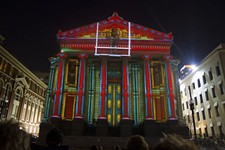P.2 Day Deux
There was evening, there was morning - a second day
By Andy Campbell and Kate X Messer, 11:00AM, Fri. Jan. 13, 2012
OPEN IMAGE GALLERY
Day Two of Prospect.2 and we’re exhausted – even after a good night’s rest. Want the gorey details? Read on!
While Kate began her day with a tour of the WWII Museum, Andy was eating a big chili-cheese dog (no, that’s not code for something!) and blogging/tweeting his little Jew-heart out in a theme café. The theme: 1940s soda shop. And yes, they did have Wi-Fi, and the password was Overlord, which at first Andy thought was some soda-shop employee’s snarky idea and tweeted as such. Air Force brat Kate, figuring it probably had some significance to military history, told Andy that D-Day was codenamed Operation Overlord. Once we realized that D-Day's iconic boats were designed by Louisianan boat builder Andrew Higgins (of whom President Eisenhower said "He is the man who won the war for us"), the National WWII Museum's place in NOLA made sense.
Operation Oops.
While Kate was delving deep into history and emotional triggers (she’ll dedicate a post to the WWII Museum later), Andy took off to see three different P.2 venues: The Contemporary Arts Center (home institution of P.2 curator Dan Cameron), The Ogden Museum of Southern Art, and Francesco Vezzoli’s installation in the Charles Moore-designed Piazza d’Italia (Moore on that later – wokka wokka).
The Contemporary Art Center hosted the most P.2 artists – George Dunbar, Karl Haendel, Ozawa Tsuyoshi, Alexis Rockman, Dan Tague, Gina Phillips, Grazia Toderia, and Ragnar Kjartansson. Not all the art was worth commenting on at the CAC, but there were some standouts… first amongst them, and given the pride of place was Dan Tague, whose fictional U.S. Department of Civil Obedience is meant to be a reflection of the current state of surveillance and Democracy. Official-looking museum vinyl lettering informs you that the exhibition has been underwritten by the USDCO and a second message, smaller and placed near the baseboards of an adjoining wall, further tell you that “You Are Under Surveillance”. Turn around and look up and sure enough – a camera is pointed right at you. Is it real? The light blinks red…. Andy stared the camera down, hoping to break it with his Marina Abramoviæ-like concentration, but to no avail. The USDCO’s faux-logo is an iconic image of a rattlesnake, mouth-open, poised to strike. Tague’s work is, in fact, the visual equivalent of that ominous reptilian rattling sound – it’s all irony until it’s not, and by then you’ve been fanged.
Gina Phillips, whose large sewn fabric panels and quilts, also made a strong showing at the CAC. Phillips, a kind of SWOON for the sewing set, relies on a limited set of visual signifiers – teeth, birds (often carrying human hands), water, clouds and decapitated heads – which are all realized in bright threads and fabrics. Eavesdropping on a couple of P.2 visitors I heard one exclaim that a new element had been added to the installation since he had last been by. Who knows if it’s true, but I’d like to think it is. I imagine the artist using the exhibition time not to rest on her laurels, but challenging herself to incubate more, making more decisions on what else belongs or doesn’t belong.
Upstairs were a host of other artists, a couple of video works, a mini-retrospective of the little-known Ab-Exer George Dunbar, and Ozawa Tsuyoshi’s photographs of women holding “guns” made out of the ingredients of regional dishes, such as Crawfish Etouffe.
The real stunner at the CAC wasn’t an exhibition affiliated with P.2, but it should have been. NOLA NOW: Part 1: Swagger for a Lost Magnificence was the first iteration of a series of exhibitions on contemporary art by New Orleanians. Packed to the brim with local artists who were not only responding to New Orleans' unique history, but to an array of conceptual artistic practices. The exhibition is an argument for a regional aesthetic, but many of the artists could be players in a national and international art world. Imagine if the two dozen or so artists were to be considered officially a part of P.2 – not only would the artist roster grow but these NOLA artists would have the experience of being programmed into an international art biennial.
None were so funny and moving in Swagger as Srdjan Loncar’s FIX-A-THING pavilion which purported to fix any item, be it plunger, cinderblock or wall with a series of collaged photographs of the object itself. Little patches of photographs purported to fix an item, but really the fix was often worse and less-authentic than the mysteriously pilloried item. Finding these “fixed things” throughout the gallery made me melancholic (really, in the Freudian sense!) for the loss of the damaged object itself. There’s something joyful and creepy about trying to fix a cinderblock with photography. The cheery, advertorial pavilion which expounded FIX-A-THING’s purpose and method gave jingoistic corporate and governmental platitudes a run for their money. Maybe FIX-A-THING can fix that too.
Another strength in NOLA NOW were the two large videos projected in black box spaces in the middle of the CAC’s third floor. Dave Greber’s Stilllives (2011) was a playful (and short) video of an ever changing table-surface strewn with blueberries, broken bottles, and multicolored tablecloths. The video adeptly makes an argument for the interrelation of video and painting, and follows in the wake of work by Leidy Churchman (his MEN video) and really anything by Pipilotti Rist. The second video, by Nina Schwanse entitled Civil Realness: Grant vs. Lee (2011), images the political fight of Ulysses S. Grant and Robert E. Lee through the lipsynching and stylings of two drag queens against a green screen. The blockish soundtrack belies the intricacy of the visual storytelling, which is in music video form. Magnificence Regained, indeed.
A couple other artists should get a shout-out here including Robin Levy whose elegant installation and video Threshold is a Matthew Barney-ian exercise in restraint and a kind of drawing with body weight, and Monica Zeringue, whose small-scale graphite on clayboard drawings (2009-2011) were enchanting and disturbing.
After the CAC Andy checked out the Ogden Museum of Southern Arts installation of Ashton T Ramsey’s clothing and collage work. Those in NOLA might recognize Ramsey’s work, and perhaps the man himself, as he often takes to the streets in an outfit of his own making, largely composed of newsprint collage. Each outfit comes with a pair of glasses that spell out one or two words – the most effective of these was a pair of glasses formed out of the word history, rendered in red and gold glitter. History’s never looked so fun! However Andy took issue with the placement of Ramsey’s work in the narrow hallway of a floor that was mostly closed, which seems especially egregious in light of square-footage accorded to the steampunk scupltor Ersy and the Storeyville soft sensibility of photographer Josephine Sacabo downstairs. Kate saw the Ramsey show later and didn’t have the same arty gripes that Andy had, guessing, instead, that since the show would be known and anticipated by locals, it was perhaps allocated its space due to square footage needs. One of the best details about the Ramsey installation was that Ramsey left his business cards for visitors to take. His card lists him as “Folk Artist Historian – Costumes of Paper Hats, Collages, Story Teller, and Reader” along with his handwritten cell phone number. Maybe an interview is in the works.
Finally, Andy set out to see Francesco Vezzoli’s contribution to P.2, sited in the Piazza d’Italia. If that sounds familiar, way to go, you remember your postmodernist architectural history, but if not, let’s fill you in. There’s nothing a ponycorn loves more than discussion of PoMo architecture. The Piazza was designed by Charles Moore as a kind of homage to and ironic playing with Italianate architectural design. Painted in garish colors, and outfitted with neon, the Piazza features metal columns cut in half, a jagged tiered water fountain/pool that sputters and shoots water in divergent directions, and paths where one has to get wet to get to the best vantage points. In other words, all post-modern jokes. Taking something as “classical” as Roman columns and colonnades and making them silly is no small feat, and Moore’s iconoclastic efforts are not only recorded as one of the first instances of Postmodernist architectural style, but also became, strangely, the foundation for hotels like the Bellagio and Paris in Las Vegas, and, a little closer to home, the “swank” outlet malls in San Marcos which are modeled to look like buildings in Venice. Look Ma! There’s the Doge’s palace, and right there in the middle of the blacktop Texas parking lot is a tiny river with a sad-looking college kid playing at being a Gondolier (that was before they replaced said sad-kid with miniature boats for racing). The Piazza itself is infamous because not ten-years after its building the site fell into ruin, left uncared for by the adjoining commercial tenants and victim to slashed NOLA budgeting. In the early 2000s money was again poured back into the Piazza to revitalize it. Thus the architectural play off of Italian architecture (which was gloriously built, fell into ruins, and then became national treasure) unwittingly mimicked the trajectory of its own source material. How’s that for a post-modern joke? And no one laughs.
Francesco Vezzoli’s intervention is a gold-plated and stylized statue of Sophia Loren, who holds a miniature version of the Piazza d’Italia. The statue is the sister-from-another-mister of Rob Pruitt’s Andy Warhol statue. It is tacky, tacky, tacky – but then again, so is the Piazza. Still Andy can’t decide whether La Loren was better because of her siting. Sophia, she was no tacky lady, but in Vezzoli’s hands (a man who once had Courtney Love and himself play the eponymous emperor in a fake movie-trailer for Gore Vidal’s Caligula) it’s hard to imagine where kitsch wouldn’t come into play.
We’re Fine & Dandy with Kate & Andy. B’duh.
A note to readers: Bold and uncensored, The Austin Chronicle has been Austin’s independent news source for over 40 years, expressing the community’s political and environmental concerns and supporting its active cultural scene. Now more than ever, we need your support to continue supplying Austin with independent, free press. If real news is important to you, please consider making a donation of $5, $10 or whatever you can afford, to help keep our journalism on stands.
Kate X Messer, July 27, 2012
Nov. 4, 2015
Aug. 26, 2021
New Orleans, LGBTQ, P.2, Dan Cameron, Ashton Ramsey, Francesco Vezzoli, Sophia Loren, PoMo Ruins, Charles Moore












